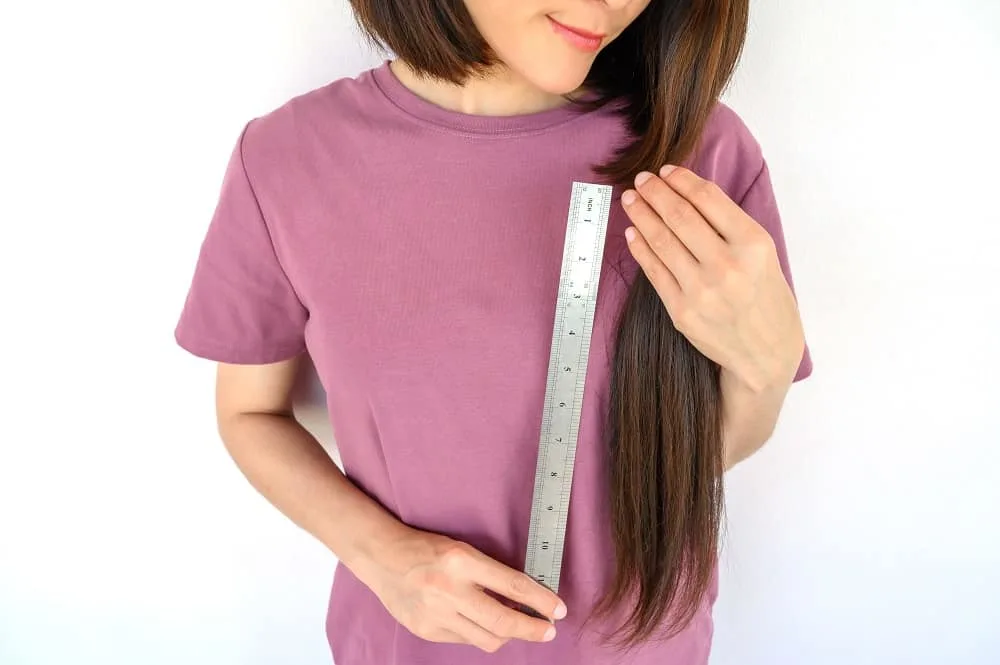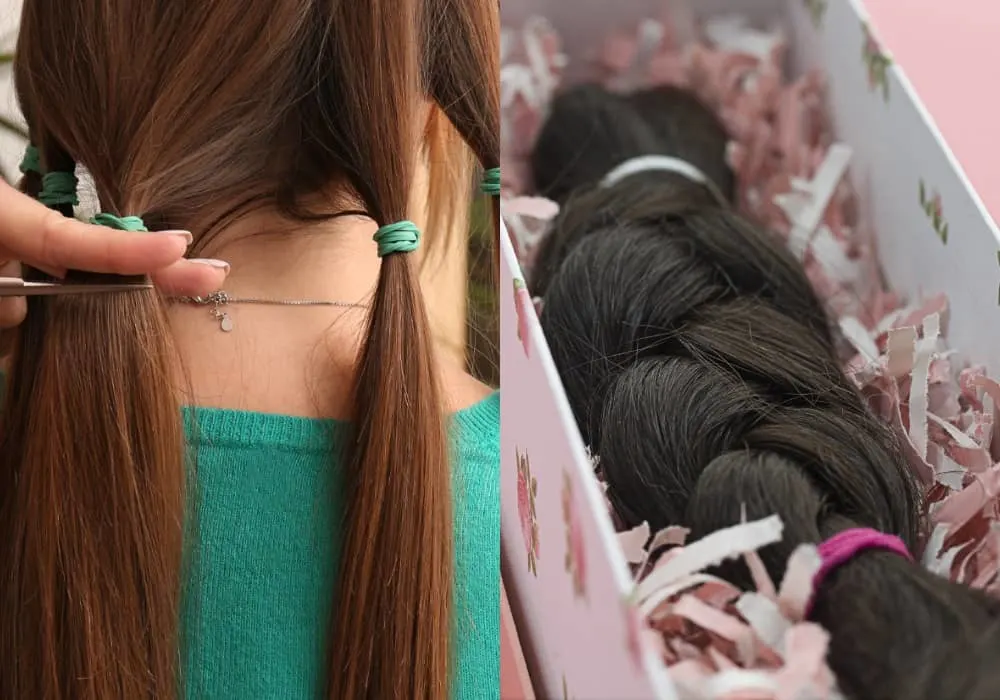Donating hair has become a popular way of helping people experiencing hair loss due to medical conditions. If you’d like to donate hair, there are several organizations you can send it to and some requirements to meet to make sure your hair donation can make the most impact on another person’s life.
Who Should Donate Hair?

Almost anyone can donate hair since the organizations that accept donated hair have a range of requirements. Whatever your hair situation, if you want to donate, you can likely find an organization that will take your hair.
Some people think they must be a “perfect” hair donor and have long, non-colored, non-gray hair. But if you have short, colored, or gray hair, don’t let that stop you from donating. You just need to choose the organization that can use your hair.
Basic Requirements for Hair Donation

You must follow the basic requirements for hair donation so your hair does not go to waste. Each organization has specific guidelines, so make sure you know what’s required by the one you choose.
In general, all donated hair must be clean and dry. Wet hair will turn mildewy, so ensure it is dry before sending it. If hair is to be made into a wig, you need to secure it with a band at least an inch below where it’s cut. Measure from where you will cut to the end of the hair to ensure it reaches the minimum length.
Once cut, leave the hair in the elastic band and place it in a sealed ziplock bag before mailing it. If you feel it’s necessary, you can secure the hair with additional elastic bands or braid it. Most organizations cannot accept loose hair, so make sure the hair is secure.
Where To Donate Hair?
There are numerous places to donate hair. They are listed here in order of the donation length requirement, beginning with the longest.
Chai Lifeline
Chai Lifeline provides a range of programs and services to support the financial, emotional, and social needs of families who have experienced a serious illness or loss. One of their services is providing wigs. They require a minimum of 14 inches for hair donations.
Wigs for Kids
Wigs for Kids helps children who are experiencing hair loss as the result of medical conditions, including cancer, alopecia, and burns. They accept hair donations reaching a minimum of 12 inches long, but they prefer it longer than 14 inches.
Hair We Share
Hair We Share provides wigs to anyone who needs one but can’t afford it. They accept donations of 12 inches or more. Hair can be dyed in natural colors and permed or straightened. They cannot accept hair that has been bleached or dyed a color that is not natural.
Locks of Love
Locks of Love provides wigs for financially disadvantaged children experiencing hair loss. Most of their wig recipients have alopecia, an autoimmune disease that causes hair loss. They also provide wigs for children undergoing cancer treatment or children who experience hair loss for some other reason.
To donate hair to Locks of Love, your hair must be at least 10 inches long. They accept colored or permed hair and can use hair that was not cut recently. They cannot use hair that has been bleached or is in dreadlocks.
Children With Hair Loss
Children With Hair Loss provides free wigs to children and young adults facing hair loss for medical reasons. They require donated hair to be at least eight inches in length.
360 Hair
360 Hair makes wigs for women battling cancer. To donate hair, it must be at least eight inches long and either braided or bound with elastic at both ends. They welcome colored and gray hair.
Wigs 4 Kids
Wigs 4 Kids, not to be confused with Wigs for Kids, provides free wigs to children and teenagers in Michigan. They prefer hair to be a minimum of 10 inches long, but they can use donations of seven inches to make wigs for boys or girls who prefer short hair.
Hair donated to Wigs for Kids cannot be color-treated or contain more than 10% gray hair.
Matter of Trust Clean Wave Program
The Clean Wave Program through Matter of Trust is a unique option for donating hair. These donations don’t go to make wigs. Instead, this environmentally-minded organization makes felted mats from hair to clean polluted water. It also diverts useful fibers, such as hair, fleece, fur, and wool, from ending up as waste.
The hair mats soak up petrochemicals in storm drains, filtration systems, and wells before those chemicals make their way to rivers and oceans.
To donate hair to the Clean Wave Program is very easy. They accept unbound ponytails of four inches or longer, and they also take loose hair that is at least an inch long and debris-free. Collect loose hair by cutting it onto a towel or mat. Don’t sweep it off the floor.
All head hair, including beards, is accepted, and it can be dyed, chemically treated, straightened, or permed.
The Hair Donation Process

Donating hair is a simple process. Follow these steps:
- After deciding which organization to donate your hair to, note their requirements
- Prepare your hair for cutting – it must be clean and dry and meet the length requirement
- Put hair in one or more ponytails with the elastic below where you will cut
- Cut your hair, making sure it is secure in the elastic
- Put your ponytails into a ziplock bag, making sure they are completely dry
- Put your bag with your hair in a mailing envelope and send it to your chosen organization
FAQs
The following are some of the most frequently asked questions about donating hair.
The minimum length for hair will vary by which organization you are donating to. The minimum length could be anywhere from 7 inches to 14 inches to make a wig or one inch to clean up the environment.
It varies. Some organizations accept dyed hair, while others do not. Furthermore, some will take dyed hair as long as it is not bleached. Make sure you understand the requirements of the organization.
Yes, you can donate hair with split ends. As long as your hair is healthy, not over-processed, and at the appropriate length, it can be donated. Any aesthetic issues with the hair, such as split ends, will likely be addressed when the hair is turned into a wig.
If hair is frizzy due to damage, it may not be suitable for donation. If it is frizzy because it is dry, try using a conditioner to hydrate it before donating. Contact your chosen organization if you have any questions about whether your hair is suitable.
Yes, but the shortest layer should meet the minimum length required by the charity, which will generally go from 8 inches to 12 inches.
While in the past, there have been some complications with making wigs out of natural afro hair, advancements in wig production methods make it possible for individuals with afro hair to be donors.
For instance, the United Kingdom-based charity The Little Princess Trust announced in 2021 that they were now working with a wig manufacturer that could accept afro hair.
Yes, men can donate their hair. All of the same rules apply to a male donor, including policies on perms, color treatment, bleaching, and dreadlocks.
No, beard hair is a different texture than the hair on your scalp, so it is not suitable to make a wig. However, you can donate beard hair to make into mats that clean chemicals from water.
Many people benefit from hair donation, from those undergoing medical treatments, such as chemotherapy, to people recovering from accidents or suffering from a disease that causes hair loss.
So if you’d like to donate hair toward a cause, just make sure to follow the instructions of the organization you’ve chosen to send your hair to. Beyond that, you simply have to cut your hair and send it and know that your hair will positively impact another person’s life.
You May Also Like
